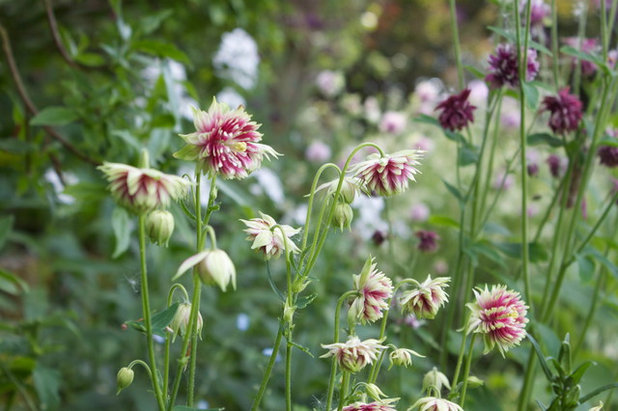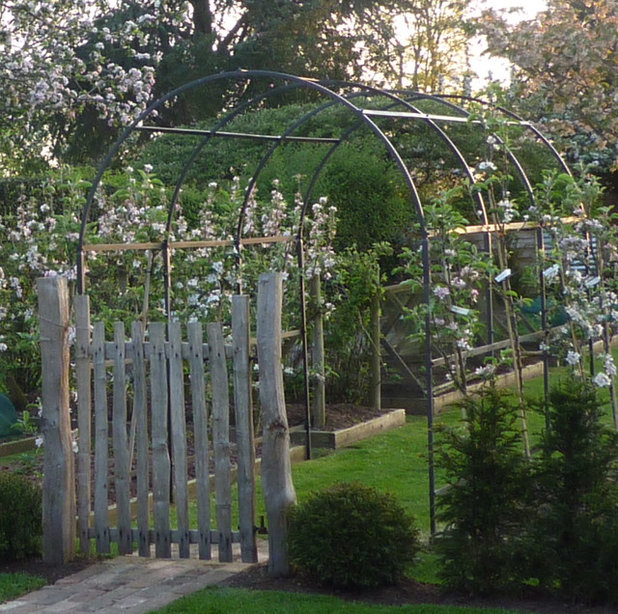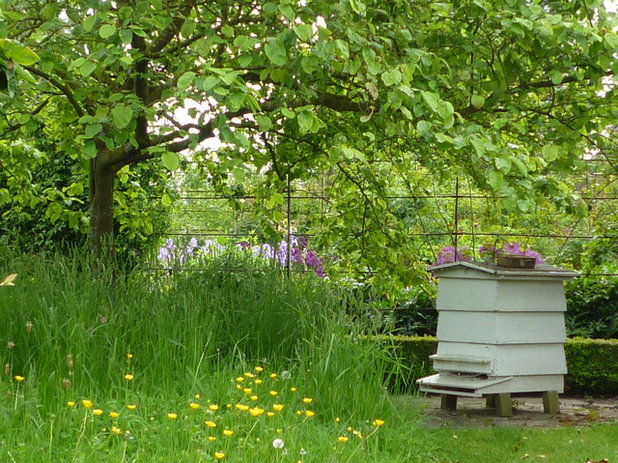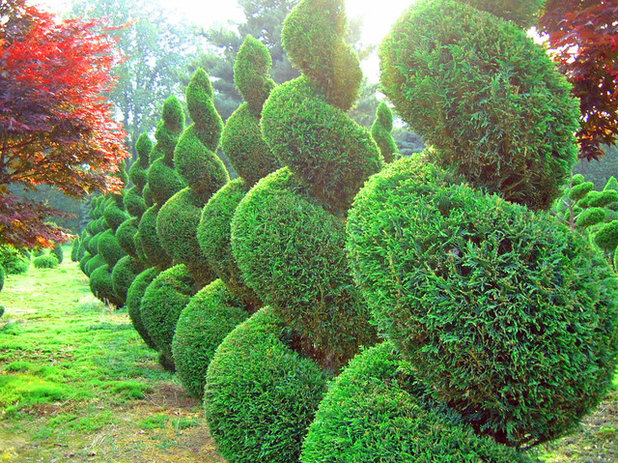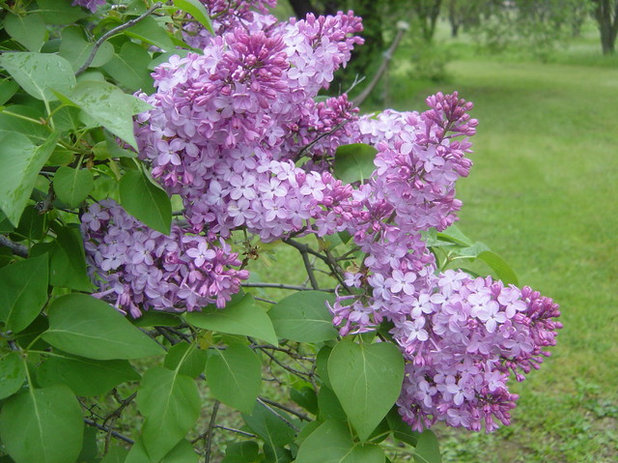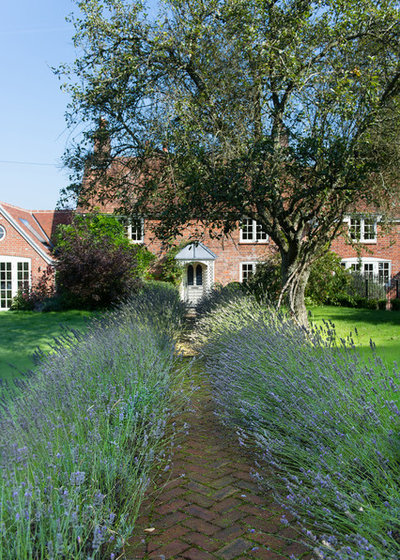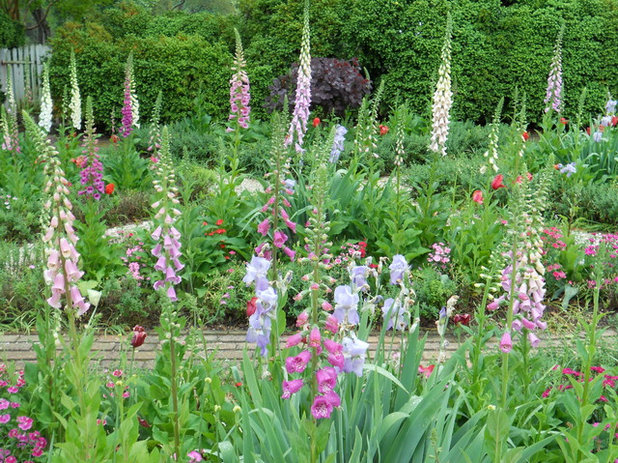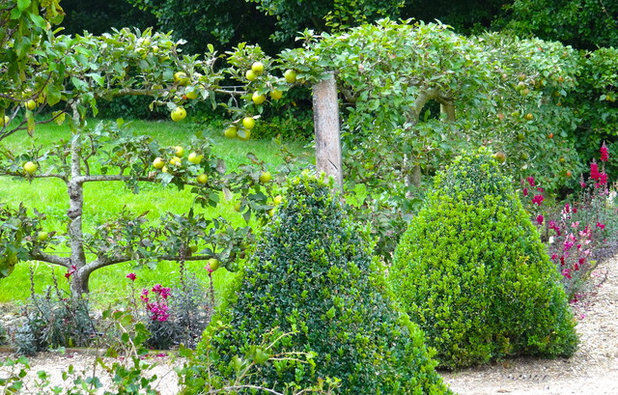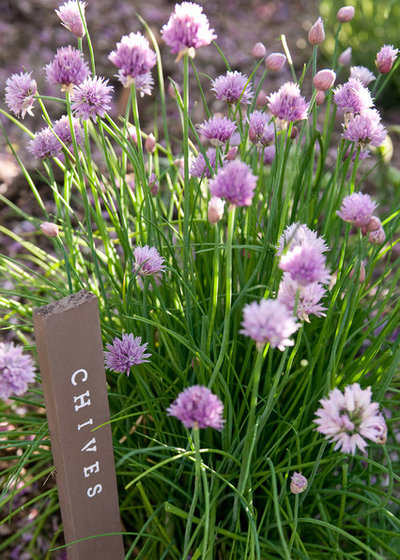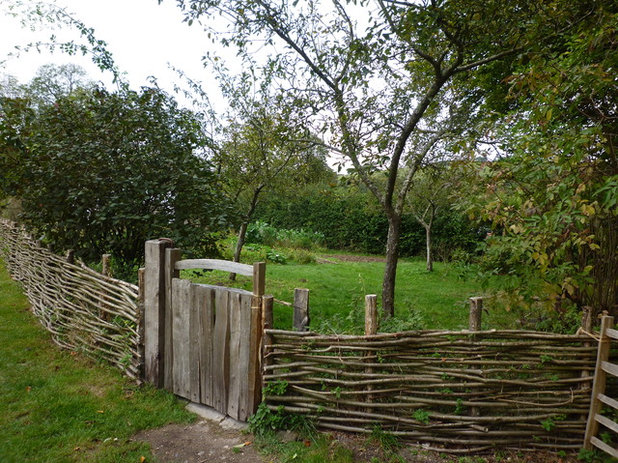How to create a cottage style Garden - You do not need an old quaint cottage to create a cottage-style garden. Just pack a lot in the borders by mixing some old flowers, useful herbs and vegetables, climbers, self-seeding annuals and productive fruit trees for an informal meeting, 'just happened' natural. With so many seeds, the birds will love it, and bees and insects will be in heaven.
See in this series: How to create a scented garden | How to Create a Jungle Garden style
See in this series: How to create a scented garden | How to Create a Jungle Garden style
Chris capacity
Get Right basic
There are so many flowering plants to include, roses, primroses, geraniums, poppies, lupins, fritillaria, forget me nots, stocks, sweet rocket, sweet William, to name a few.
Add an old brick path, Belfast had a sink, a little topiary, pergolas wood or woven, an arbor smothered in roses, old terracotta pots, rustic fences hedges, vegetable bells, a few pots forcing rhubarb and a hive, and you have that magical mix for the perfect cottage garden
There are so many flowering plants to include, roses, primroses, geraniums, poppies, lupins, fritillaria, forget me nots, stocks, sweet rocket, sweet William, to name a few.
Add an old brick path, Belfast had a sink, a little topiary, pergolas wood or woven, an arbor smothered in roses, old terracotta pots, rustic fences hedges, vegetable bells, a few pots forcing rhubarb and a hive, and you have that magical mix for the perfect cottage garden
Claudia Yong design Garden
Choose your flowers
Commonly known as bonnets or columbines grandmother, nodding columbine products, spurred flowers with delicate leaves that self-seeds all over the beds. There are so many colors available, from deep blue to pale mauve, pinks, creams and bi-colors and double forms like the beautiful rose 'Nora Barlow', as seen in this garden. The deeper, double 'Black Barlow' looks amazing team with grass borders, as Luzula nivea .
Hardy geraniums are a favorite cabin, too, and make a good ground cover, especially under the roses. Peonies ( Paeonia officinalis ) and poppies ( Papaver ) are some forbs associated with cottage gardens. They have large blowsy flowers in both vibrant colors or soft colors. One of my favorite is Papaver orientale 'Patty Plum'.
There are many more cottage-style plants - here are a few: roses ( Dianthus ), lady's mantle ( Alchemilla ), primroses ( Primula vulgaris ), Salvia , snowdrops ( Galanthus nivalis ), nasturtiums ( Tropaeolum majus ), lupins ( Lupinus ), thoughts ( Viola ) and wallflowers ( Cheiranthus cheiri ).
Commonly known as bonnets or columbines grandmother, nodding columbine products, spurred flowers with delicate leaves that self-seeds all over the beds. There are so many colors available, from deep blue to pale mauve, pinks, creams and bi-colors and double forms like the beautiful rose 'Nora Barlow', as seen in this garden. The deeper, double 'Black Barlow' looks amazing team with grass borders, as Luzula nivea .
Hardy geraniums are a favorite cabin, too, and make a good ground cover, especially under the roses. Peonies ( Paeonia officinalis ) and poppies ( Papaver ) are some forbs associated with cottage gardens. They have large blowsy flowers in both vibrant colors or soft colors. One of my favorite is Papaver orientale 'Patty Plum'.
There are many more cottage-style plants - here are a few: roses ( Dianthus ), lady's mantle ( Alchemilla ), primroses ( Primula vulgaris ), Salvia , snowdrops ( Galanthus nivalis ), nasturtiums ( Tropaeolum majus ), lupins ( Lupinus ), thoughts ( Viola ) and wallflowers ( Cheiranthus cheiri ).
Claudia De Yong Garden Design
stall your climbers
climbers need support and in the cottage garden you can use arbors, pergolas and arches. Allow plants such as jasmine, roses, clematis, wisteria, honeysuckle, beans and sweet peas to scramble up these structures; they will add height and the creation of a "door" natural in another part of the garden.
Another plant to consider for an arbor is the golden jump Humulus lupulus aureus . With its large leaves, there is a vigorous climber and the space needs to spread. When the leaves of this plant turn a golden yellow in the fall, and it is covered with flower pendant conical who turn to hops, it makes a nice addition to the interior if you reduce the long braids .
Alternatively underplant foundation supports with annual nasturtium self-seeding. A favorite for cottage, nasturtium will even blur the fences and through the gates with a mass of orange trumpet flowers and circular leaves throughout the summer.
climbers need support and in the cottage garden you can use arbors, pergolas and arches. Allow plants such as jasmine, roses, clematis, wisteria, honeysuckle, beans and sweet peas to scramble up these structures; they will add height and the creation of a "door" natural in another part of the garden.
Another plant to consider for an arbor is the golden jump Humulus lupulus aureus . With its large leaves, there is a vigorous climber and the space needs to spread. When the leaves of this plant turn a golden yellow in the fall, and it is covered with flower pendant conical who turn to hops, it makes a nice addition to the interior if you reduce the long braids .
Alternatively underplant foundation supports with annual nasturtium self-seeding. A favorite for cottage, nasturtium will even blur the fences and through the gates with a mass of orange trumpet flowers and circular leaves throughout the summer.
Claudia De Yong Garden Design
Say hello to a hive
Have a hive, even if it is just for decorative purposes, always look romantic in a garden cottage. You do not have to buy a hive if you will not keep bees. You can now buy a double hive, which is actually a small storage box or compost bin, or try to do with the dry wood. You can easily paint and secure a felt or zinc roof on top to stop the water damage.
Either place the hive on a brick path or on a grassy area, where you can allow buttercups and clover to snuggle against the legs for a really natural look.
Other features include ornaments in a cottage-style garden have seats and arbours - a shaded green area, away - forcing Victorian pots, bells and old chimney pots. Traditionally, the cottage garden was often full of discarded objects found or which have been used and reused, possibly as a decoration in the middle of the beds or on the roads, or even as a focal point.
Have a hive, even if it is just for decorative purposes, always look romantic in a garden cottage. You do not have to buy a hive if you will not keep bees. You can now buy a double hive, which is actually a small storage box or compost bin, or try to do with the dry wood. You can easily paint and secure a felt or zinc roof on top to stop the water damage.
Either place the hive on a brick path or on a grassy area, where you can allow buttercups and clover to snuggle against the legs for a really natural look.
Other features include ornaments in a cottage-style garden have seats and arbours - a shaded green area, away - forcing Victorian pots, bells and old chimney pots. Traditionally, the cottage garden was often full of discarded objects found or which have been used and reused, possibly as a decoration in the middle of the beds or on the roads, or even as a focal point.
Oriental Landscape Art of Lee
Extract to perfection
Topiary is an important element of the cottage garden, adding a structure for the winter months and provide a backdrop for most perennials. Although Holly has traditionally been more widely used, other evergreen shrubs have become trained in fashion features garden cottage.
Plants such as the vector if ( Taxus baccata ), which can be cut into various shapes, or Buxus sempervirens are most often shaped into simple shapes or complex. The two yews and Buxus can be purchased cone ball Spiral-, or plants pyramid, and if you feel creative with the mower, you can create your own squirrel or topiary peacock!
another good clip to plant is Lonicera nitida , which is slow growing and has a small leaf. It can also be used as a low hedge between the edges or along a path.
Topiary is an important element of the cottage garden, adding a structure for the winter months and provide a backdrop for most perennials. Although Holly has traditionally been more widely used, other evergreen shrubs have become trained in fashion features garden cottage.
Plants such as the vector if ( Taxus baccata ), which can be cut into various shapes, or Buxus sempervirens are most often shaped into simple shapes or complex. The two yews and Buxus can be purchased cone ball Spiral-, or plants pyramid, and if you feel creative with the mower, you can create your own squirrel or topiary peacock!
another good clip to plant is Lonicera nitida , which is slow growing and has a small leaf. It can also be used as a low hedge between the edges or along a path.
Pamela Bateman Garden Design
Breathe lilac
lilac Sweet-smelling is short like a tree or flowering shrub, but no cottage garden should be without one; it is a pity they are not often planted.
When mature, lilac, with their twisted trunks of character, look good planted next to fruit trees and understory with sweet rocket, bulbs and foxgloves. Besides the well known Syringa vulgaris cultivars, you might also consider planting Syringa pubescens subsp microphylla 'Superba', which bloom in spring but as well in October, although the flowers will be intermittently later in the year. It can also be grown as a hedge or shrub wall.
lilac Sweet-smelling is short like a tree or flowering shrub, but no cottage garden should be without one; it is a pity they are not often planted.
When mature, lilac, with their twisted trunks of character, look good planted next to fruit trees and understory with sweet rocket, bulbs and foxgloves. Besides the well known Syringa vulgaris cultivars, you might also consider planting Syringa pubescens subsp microphylla 'Superba', which bloom in spring but as well in October, although the flowers will be intermittently later in the year. It can also be grown as a hedge or shrub wall.
architecture Absolute
sky path brick
a brick path leading to the door and lined with lavender is what many people picture when they think of a traditional cottage garden. brick paths can be laid in straight or curved lines around the borders that lead to a plant area or side of a house.
The traditional way to brick paths pose was in bed bricks directly on a sand base. This meant that the roads were permeable to water, but it has not always hold their shape over time. It also meant that small seeds and plants naturalize in the cracks. Nowadays, brick paths are usually bedded on sand and cement mixture low, which is also used for reporting. Neither method is better than another - it really depends on your preference and how the path will be used.
If you put in a new way bricks, make sure to choose free gel bricks, as frozen water can damage their structure otherwise. There are many poses of models to choose from, such as herringbone or stretcher bond Basketweave styles.
You can use bricks on board boundaries, as the Victorians did. They seem well positioned at a 45 degree angle, so that the tops of the bricks are triangular shapes. This will keep in straggling plants and neaten edges.
To the edge of a brick path with lavender, choose varieties Munstead '' Hidcote 'or. Nepeta racemosa 'Walker's Low' (catnip) also works great in the garden cottage along the paths, especially if your soil is not free draining, which is not suitable for lavender.
a brick path leading to the door and lined with lavender is what many people picture when they think of a traditional cottage garden. brick paths can be laid in straight or curved lines around the borders that lead to a plant area or side of a house.
The traditional way to brick paths pose was in bed bricks directly on a sand base. This meant that the roads were permeable to water, but it has not always hold their shape over time. It also meant that small seeds and plants naturalize in the cracks. Nowadays, brick paths are usually bedded on sand and cement mixture low, which is also used for reporting. Neither method is better than another - it really depends on your preference and how the path will be used.
If you put in a new way bricks, make sure to choose free gel bricks, as frozen water can damage their structure otherwise. There are many poses of models to choose from, such as herringbone or stretcher bond Basketweave styles.
You can use bricks on board boundaries, as the Victorians did. They seem well positioned at a 45 degree angle, so that the tops of the bricks are triangular shapes. This will keep in straggling plants and neaten edges.
To the edge of a brick path with lavender, choose varieties Munstead '' Hidcote 'or. Nepeta racemosa 'Walker's Low' (catnip) also works great in the garden cottage along the paths, especially if your soil is not free draining, which is not suitable for lavender.
Paintbox Garden
include favorites
the foxglove ( Digitalis purpurea ) is a biennial, which would have naturally found its place in the cottage garden surrounding fields. Therefore, once planted in your own garden, foxgloves will also soon appear in all the unexpected places and thrive in the shade. Foxgloves flower and produce seeds in their second year, so you must plant them two consecutive years to get flowering plants every summer.
No cottage garden should be without another favorite tall hollyhock ( Alcea rosea ). Hollyhocks, however, with their huge leaves and large flowers are susceptible to hollyhock rust, a fungal infection, which can make the plants look untidy. As such, even if they are perennials, they are often planted biennials since the cast after they bloomed reduced the threat of rust.
Lupins ( Lupinus ) and delphiniums (part of larkspur - Ranunculaceae - family) are also staples of the garden cottage. Lupins, hollyhocks like, do not require a rich soil or pampering but delphiniums will need food and staking.
the foxglove ( Digitalis purpurea ) is a biennial, which would have naturally found its place in the cottage garden surrounding fields. Therefore, once planted in your own garden, foxgloves will also soon appear in all the unexpected places and thrive in the shade. Foxgloves flower and produce seeds in their second year, so you must plant them two consecutive years to get flowering plants every summer.
No cottage garden should be without another favorite tall hollyhock ( Alcea rosea ). Hollyhocks, however, with their huge leaves and large flowers are susceptible to hollyhock rust, a fungal infection, which can make the plants look untidy. As such, even if they are perennials, they are often planted biennials since the cast after they bloomed reduced the threat of rust.
Lupins ( Lupinus ) and delphiniums (part of larkspur - Ranunculaceae - family) are also staples of the garden cottage. Lupins, hollyhocks like, do not require a rich soil or pampering but delphiniums will need food and staking.
Claudia De Yong Garden Design
Add fruity delights
productive fruit trees are often found in the beds of cottage gardens and can also be grown as stepovers or cords space is limited.
The most obvious fruit trees are apples, pears, plums, cherries and gages. But if you have room, try to grow a mulberry tree, which is better suited to a large garden, or a medlar ( Mespilus germanica ), which has a nice habit of spreading to something a little different.
Do not forget to plant an apple crab, as Malus 'Evereste', which can also be trained to grow in a pleached style, adding height and between the areas of garden.
Learn what to do in the garden in March
productive fruit trees are often found in the beds of cottage gardens and can also be grown as stepovers or cords space is limited.
The most obvious fruit trees are apples, pears, plums, cherries and gages. But if you have room, try to grow a mulberry tree, which is better suited to a large garden, or a medlar ( Mespilus germanica ), which has a nice habit of spreading to something a little different.
Do not forget to plant an apple crab, as Malus 'Evereste', which can also be trained to grow in a pleached style, adding height and between the areas of garden.
Learn what to do in the garden in March
Lucy Call
not include herbs and vegetables, too
herbs and vegetables play an important role in a cottage-style garden and were traditionally planted among the plants to herbaceous flowers, not only for food, but also - in the case of herbs - to repel insects. The herbs are also grown for medicinal purposes, for Dyes and treat diseases. (They were also once thought to ward off witches!)
Choose vegetable varieties such as red beet leaves 'Bull's Blood', lettuce red frilly, such as "Lollo Rosso" and swiss chard to give contrast and add interest.
Staple herbs include chives are ( Allium schoenoprasum ), who always look good in the garden and self-seed, appear in the spaces between the bricks and to be a good way border plant. Sage ( Salvia officinalis ), especially the purple variety, is an aromatic, semi-evergreen shrub that never disappoints and is much like catnip ( Nepeta ). Rosemary ( Rosmarinus officinalis ) is always a good choice, too, and thyme ( Thymus vulgaris ) has many different varieties of reptiles with large shrubs formation mound.
herbs and vegetables play an important role in a cottage-style garden and were traditionally planted among the plants to herbaceous flowers, not only for food, but also - in the case of herbs - to repel insects. The herbs are also grown for medicinal purposes, for Dyes and treat diseases. (They were also once thought to ward off witches!)
Choose vegetable varieties such as red beet leaves 'Bull's Blood', lettuce red frilly, such as "Lollo Rosso" and swiss chard to give contrast and add interest.
Staple herbs include chives are ( Allium schoenoprasum ), who always look good in the garden and self-seed, appear in the spaces between the bricks and to be a good way border plant. Sage ( Salvia officinalis ), especially the purple variety, is an aromatic, semi-evergreen shrub that never disappoints and is much like catnip ( Nepeta ). Rosemary ( Rosmarinus officinalis ) is always a good choice, too, and thyme ( Thymus vulgaris ) has many different varieties of reptiles with large shrubs formation mound.
Claudia De Yong Garden Design
Choose the right fence
fencing rustic style instantly creates an architectural element of cottage style. traditional, natural woven hazel or willow fencing is the preferred choice. You can also use a short fence that you can paint in the color of your choice.
Hazel panels, once used for sheep, can be purchased in sizes from standard fence panels or, for a real, custom, handmade finish, find a barrier manufacturer local, which will close, providing beautiful chestnut messages and even make you a little door to the garden entrance. The hazel panels should last a good eight years of treatment.
Even you do not have fencing around your garden, consider planting a native hedge, preferably a mixture beech and spine to encourage wildlife and year interest.
Tell us ...
Which element of the cottage garden is your favorite? Share your thoughts in the comments below.
fencing rustic style instantly creates an architectural element of cottage style. traditional, natural woven hazel or willow fencing is the preferred choice. You can also use a short fence that you can paint in the color of your choice.
Hazel panels, once used for sheep, can be purchased in sizes from standard fence panels or, for a real, custom, handmade finish, find a barrier manufacturer local, which will close, providing beautiful chestnut messages and even make you a little door to the garden entrance. The hazel panels should last a good eight years of treatment.
Even you do not have fencing around your garden, consider planting a native hedge, preferably a mixture beech and spine to encourage wildlife and year interest.
Tell us ...
Which element of the cottage garden is your favorite? Share your thoughts in the comments below.

